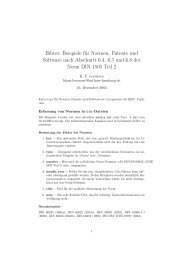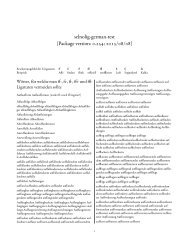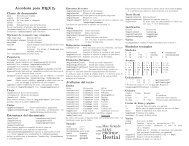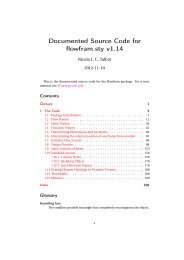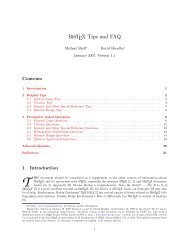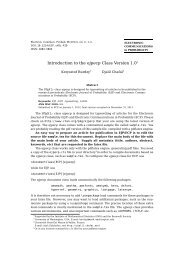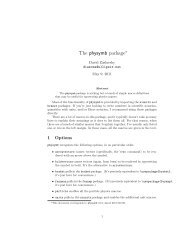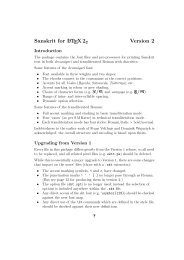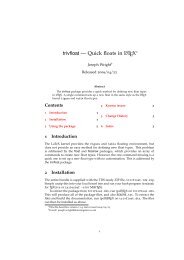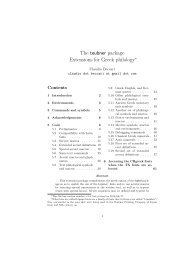multido-doc.pdf.
multido-doc.pdf.
multido-doc.pdf.
You also want an ePaper? Increase the reach of your titles
YUMPU automatically turns print PDFs into web optimized ePapers that Google loves.
Documentation for <strong>multido</strong>.tex, version 1.42:<br />
A loop macro for Generic TEX<br />
Timothy Van Zandt ∗<br />
Version 1.42<br />
May 14, 2010<br />
<strong>multido</strong>.tex/<strong>multido</strong>.sty contains the \<strong>multido</strong> macro, which is a loop<br />
facility for Generic TeX. This macro happens to be useful for drawing pictures,<br />
and was originally developed for the PSTricks package, 1 but you can<br />
use it for other purposes as well.<br />
A special feature is support of fixed-point addition. For example, PSTricks<br />
uses the \<strong>multido</strong> to put numbers on axes, much like in the following L ATEX<br />
example:<br />
\setlength{\unitlength}{1cm}<br />
\small<br />
\begin{picture}(8,1)(0,-.5)<br />
\put(0,0){\vector(1,0){8}}<br />
\<strong>multido</strong>{\i=0+1,\n=0+0.25}{8}{%<br />
\put(\i,-.1){\line(0,1){.2}}<br />
\put(\i,-.2){\makebox(0,0)[t]{\n}}}<br />
\end{picture}<br />
0 0.25 0.50 0.75 1.00 1.25 1.50 1.75<br />
The general syntax for \<strong>multido</strong> is:<br />
\<strong>multido</strong>{variables}{repetitions}{stuff}<br />
stuff is whatever you want repeated; it can be any balanced TEX input.<br />
repetitions is the number times stuff is repeated.<br />
The first argument is the interesting one. variables is a comma-separated list<br />
of variable declarations. 2 Each variable declaration is of the form:<br />
∗ Author’s address: Department of Economics, Princeton University, Princeton, NJ<br />
08544-1021, USA. Internet: tvz@Princeton.EDU. This <strong>doc</strong>ument was edited by Rolf<br />
Niepraschk Rolf.Niepraschk@gmx.de and Herbert Voss hvoss@tug.org to get it run<br />
with LaTeX2e (2006-01-01)<br />
1 PSTricks is an extensive collection of PostScript-based macros for Generic TeX. It is<br />
available from CTAN://graphics/pstricks/.<br />
2 Don’t use commas to mark the decimal point within the variables argument, as they<br />
will be confused for delimiters.<br />
1<br />
✲
Documentation for <strong>multido</strong>.tex v.1.42 May 14, 2010 2<br />
variable = initial value + increment<br />
variable is a command sequence that can be used in stuff. It is initially set<br />
to initial value, and is then incremented by increment with each repetition.<br />
The first letter of the variable name determines the variable type. There are<br />
four variable types:<br />
Dimension (d or D) The initial value and the increment should be dimensions(lengths,<br />
inL ATEXparlance). Thesubstitutiontextisadimension,<br />
with sp units. E.g., \dx=4cm+5pt. 3<br />
Number (n or N) The initial value and increment should be integers or<br />
numbers with the same number of digits to the right of the decimal.<br />
The one exception is that it is always OK for the initial value to be<br />
an integer. There can be at most 8 digits on each side of the decimal.<br />
The substitution text is a number, with fixed-point addition. E.g.,<br />
\n=3+7.05, \Nx=5.30+-1.25.<br />
Integer (i or I) The initial value and increment should be integers. This<br />
gives the same result as using a number variable, but it is faster. E.g.,<br />
\I=2+-1.<br />
Real (r or R) The initial value and increment should be integers or numbers<br />
with at most 4 digits on each side of the decimal. The substitution<br />
text is a number, but with floating point addition and occasional small<br />
errors. This gives a less satisfactory result than using a number variable,<br />
but it is faster. E.g., \ry=4.2+1.05.<br />
Here are some examples that illustrate how the substitution text is determined:<br />
\<strong>multido</strong>{}{10}{\TeX\ }<br />
TEX TEX TEX TEX TEX TEX TEX TEX TEX TEX<br />
\<strong>multido</strong>{\d=2pt+3pt}{5}{\d, }<br />
131072sp, 327680sp, 524288sp, 720896sp, 917504sp,<br />
\<strong>multido</strong>{\n=2+3}{10}{\n, }<br />
2, 5, 8, 11, 14, 17, 20, 23, 26, 29,<br />
\<strong>multido</strong>{\i=2+-3}{10}{\i, }<br />
2, -1, -4, -7, -10, -13, -16, -19, -22, -25,<br />
\<strong>multido</strong>{\r=2+3.05}{6}{\r, }<br />
2.0, 5.05, 8.1, 11.15001, 14.20001, 17.25002,<br />
3 For PSTricks users, the unit is optional.
Documentation for <strong>multido</strong>.tex v.1.42 May 14, 2010 3<br />
\<strong>multido</strong>{\n=2.00+-3.05}{8}{\n, }<br />
2.00, -1.05, -4.10, -7.15, -10.20, -13.25, -16.30, -19.35,<br />
Here are some details about the choice of names:<br />
• Your computer won’t explode if you use names that conflict with TEX<br />
internal commands, but you might want to check name conflicts if you<br />
get inexplicable errors. The command \MultidoCheckNames can be<br />
useful in this case. It causes \<strong>multido</strong> to report an error whenever you<br />
use a variable name that is already defined. But see the next item.<br />
• The whole \<strong>multido</strong> loop is grouped. This means, e.g., that although<br />
\i is a Plain TEX command sequence (giving a dotless “ı”), you can<br />
use the variable \i if you do not use any dotless i’s in stuff (and if you<br />
do not use \MultidoCheckNames).<br />
Here are a few more details:<br />
• \Multido commands can be nested.<br />
• Spaces after a \<strong>multido</strong> command are ignored. This makes \<strong>multido</strong><br />
more hospitable for pictures.<br />
• Spaces between thevariouspartsofthe variables argument areignored.<br />
And finally here a few special features, some of which are of interest mainly<br />
macro writers and other TEXnicians:<br />
• The material that is repeated is not grouped, so that you can insert<br />
your own recursive routines.<br />
• There is a variant, \m<strong>multido</strong>, which works just like \<strong>multido</strong> except<br />
that the variables are all incremented once before starting.<br />
• If you use \Multido or \MMultido instead of \<strong>multido</strong> or \m<strong>multido</strong>,<br />
resp., then the whole loop is not grouped. This can be useful, e.g., for<br />
making entries in an alignment environment. However, these cannot<br />
be nested within any \<strong>multido</strong> macro.<br />
• If the number of repetitions is a negative number, the variables are<br />
incremented backwards.<br />
• Thecount register\<strong>multido</strong>count keeps trackofthenumber ofcurrent<br />
iteration.<br />
• The command \<strong>multido</strong>stop causes the \<strong>multido</strong> loop to quit at the<br />
end of the current iteration.
Documentation for <strong>multido</strong>.tex v.1.42 May 14, 2010 4<br />
• Fixed point addition is performed by \fpAdd and \fpSub:<br />
\fpAdd{num1}{num2}{command}<br />
\fpSub{num1}{num2}{command}<br />
num2 is added to or subtracted from num1, and the answers is stored<br />
inthecommand sequence given asthe thirdargument. The rules about<br />
decimals and so on that apply to number variables apply here as well.<br />
E.g., after<br />
\fpSub{1.75}{-0.15}{\answer}<br />
the definition of \answer is 1.90.<br />
Changes:<br />
V1.1 Fixed bug in \FPadd that gave wrong answer for, e.g., 3.4+−0.2.<br />
V1.2 Made unit optional for dimension variables when using PSTricks.<br />
V1.3 Now 0 repetitions really gets 0 repetitions. \def\<strong>multido</strong>@ changed<br />
to \long\def\<strong>multido</strong>@.<br />
V1.4 Small change to make it compatible with PSTricks v0.93 and later.<br />
V1.41 Fix bug when using the fp-package (same macronames) and small<br />
changes to this <strong>doc</strong>umentation (RN/HV)




